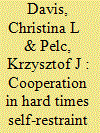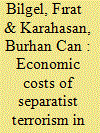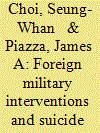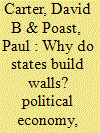|
|
|
Sort Order |
|
|
|
Items / Page
|
|
|
|
|
|
|
| Srl | Item |
| 1 |
ID:
151151


|
|
|
|
|
| Summary/Abstract |
Despite the prevalence of nonviolent uprisings in recent history, no existing scholarship has produced a generalized explanation of when and where such uprisings are most likely to occur. Our primary aim in this article is to evaluate whether different available models—namely, grievance approaches, modernization theory, resource mobilization theory, and political opportunity approaches—are useful in explaining the onset of major nonviolent uprisings. We assemble a reduced list of correlates based on each model and use each model’s out-of-sample area under the curve and logarithmic score to test each theory’s explanatory power. We find that the political opportunity model performs best for both in- and out-of-sample cases, though grievance and resource mobilization approaches also provide some explanatory power. We use a culled model of the predicted probabilities of the strongest-performing variables from all models to forecast major nonviolent uprisings in 2011 and 2012. In this out-of-sample test, all models produce mixed results, suggesting greater emphasis on agency over structure in explaining these episodes.
|
|
|
|
|
|
|
|
|
|
|
|
|
|
|
|
| 2 |
ID:
151155


|
|
|
|
|
| Summary/Abstract |
Hard times give rise to greater demand for protection. International trade rules include provisions that allow for raising barriers to aid industries when they suffer economic injury. Yet widespread use of flexibility measures may undermine the trade system and worsen economic conditions. How do states balance these conflicting pressures? This article assesses the effect of crises on cooperation in trade. We hypothesize that governments impose less protectionism during economic crisis when economic troubles are widespread across countries than when they face crisis in isolation. The lesson of Smoot–Hawley and coordination through international economic institutions represent mechanisms of informal governance that encourage cooperation to avoid a spiral of protectionism. Analysis of industry-level data on protection measures for the period from 1996 to 2011 provides support for our claim that under conditions of shared hard times, states exercise strategic self-restraint to avoid beggar-thy-neighbor policies.
|
|
|
|
|
|
|
|
|
|
|
|
|
|
|
|
| 3 |
ID:
151157


|
|
|
|
|
| Summary/Abstract |
Turkey has been suffering from separatist terrorism and the political conflict it implies since the mid-1980s, both of which are believed to have a negative impact on economic welfare. This article investigates the economic costs of Kurdistan Workers’ Party (PKK) terrorism, particularly in the Eastern and Southeastern provinces of Turkey by invoking the synthetic control method. We create a synthetic control group that mimics the socioeconomic characteristics of the provinces exposed to terrorism before the PKK terrorism emerged in the mid-1980s. We then compare the real gross domestic product (GDP) of the synthetic provinces without terrorism to the actual provinces with terrorism for the period 1975 to 2001. Causal inference is carried out by comparing the real per capita GDP gap between the synthetic and actual provinces against the intensity of PKK terrorist activity. Extended over a period of fourteen years (1988 to 2001), we find that after the emergence of terrorism, the per capita real GDP in Eastern and Southeastern Anatolia declined by about 6.6 percent relative to a comparable synthetic Eastern and Southeastern Anatolia without terrorism.
|
|
|
|
|
|
|
|
|
|
|
|
|
|
|
|
| 4 |
ID:
151156


|
|
|
|
|
| Summary/Abstract |
United Nations (UN) General Assembly votes have become the standard data source for measures of states preferences over foreign policy. Most papers use dyadic indicators of voting similarity between states. We propose a dynamic ordinal spatial model to estimate state ideal points from 1946 to 2012 on a single dimension that reflects state positions toward the US-led liberal order. We use information about the content of the UN’s agenda to make estimates comparable across time. Compared to existing measures, our estimates better separate signal from noise in identifying foreign policy shifts, have greater face validity, allow for better intertemporal comparisons, are less sensitive to shifts in the UN’ agenda, and are strongly correlated with measures of liberalism. We show that the choice of preference measures affects conclusions about the democratic peace.
|
|
|
|
|
|
|
|
|
|
|
|
|
|
|
|
| 5 |
ID:
151150


|
|
|
|
|
| Summary/Abstract |
This study examines the effect of foreign military interventions on the incidence of suicide attacks. It presents three theoretical explanations. Foreign military interventions may boost insurgent use of suicide attacks by (a) fomenting a nationalist backlash that sanctions the use of more extreme and unconventional tactics like suicide attacks, (b) providing more and better targets against which suicide attacks can be launched, or (c) prompting insurgents to use suicide tactics in order to overcome their power asymmetries and to confront better defended targets that are enhanced by interventions. We test these competing explanations using a battery of statistical tests on cross-national, time-series data for 138 countries during the period from 1981 to 2005. We find that only foreign interventions with specific features—pro-government interventions involving larger numbers of ground troops—boost suicide attacks in countries experiencing interventions. This finding suggests that by tipping the balance of power against insurgents and hardening targets in the context of assisting a local government, foreign military interventions are likely to increase the use of suicide attacks by regime challengers.
|
|
|
|
|
|
|
|
|
|
|
|
|
|
|
|
| 6 |
ID:
151154


|
|
|
|
|
| Summary/Abstract |
Recognition is vital for conflict resolution. This study was designed to learn more about the factors underlying the willingness to recognize the pain and suffering of the opponent in the asymmetrical protracted conflict between Israelis and Palestinians. Data were collected through a public opinion survey conducted with a representative sample of Israeli-Jewish adults (N = 511). Perceptions of threat/distrust toward Palestinians and dehumanization of Palestinians each made a significant contribution to explaining Jewish-Israeli (un)willingness to recognize Palestinian pain and suffering (R2 = .36). Hawkishness made an added significant contribution to the overall explanatory power of the model (R2 = .38). Higher scores on the threat/distrust scale and the dehumanization scale, as well as higher hawkishness predicted decreased willingness to recognize Palestinian pain and suffering. The implications of our findings for understanding the role of recognition and of moral concern in conflict resolution are discussed.
|
|
|
|
|
|
|
|
|
|
|
|
|
|
|
|
| 7 |
ID:
151153


|
|
|
|
|
| Summary/Abstract |
We examine the social dynamics of crime by means of evolutionary game theory, and we model the choice of boundedly rational potential victims to privately self-protect against prospective offenders. Negative externalities from self-protection, as the socially transmitted fear of victimization, can influence the strategic choices of victims even with constant or declining crime rates, and this circumstance may lead to Pareto inefficient equilibria with excessive expenses for private protection. Providing higher levels of public security (or of appropriate social care) financed through discriminatory taxation of private defensive behaviors can prevent crime and reduce superfluous self-protection, thus driving the social dynamics toward a more efficient equilibrium. Public policy can therefore be effective in implementing the social optimum. This article extends previous work by Cressman, Morrison, and Wen by increasing the range of possible dynamics and the scope for public intervention. Consequently, in our model, public policy can deter crime and improve the welfare of victims by addressing the intangible aspects of crime, that is, the social dynamics of fear.
|
|
|
|
|
|
|
|
|
|
|
|
|
|
|
|
| 8 |
ID:
151152


|
|
|
|
|
| Summary/Abstract |
Both threats and assurances can be useful in international negotiations. Threats help convince the adversary that a state will fight if challenged, and assurances can convince the adversary that a state will not attack if not challenged. We develop a model that analyzes when threats and assurances are used. Threats are widely useful because there is typically a range of outcomes that are preferable to war for each side, and threats can secure a better deal within that range by strengthening a state’s bottom line. In contrast, assurances are only necessary when war would result without them because of insufficiently valued intermediate outcomes or shifting power. We discuss insights from the model, including the role of false assurances, in the context of both the Sudetenland crisis and Cold War Europe.
|
|
|
|
|
|
|
|
|
|
|
|
|
|
|
|
| 9 |
ID:
151149


|
|
|
|
|
| Summary/Abstract |
Borders constitute the international system of states. Accordingly, states will, from time to time, take assertive measures to secure the border, with among the most aggressive strategies being the construction of physical barriers, which we refer to as “border walls.” Using original data on man-made border wall construction from 1800 to 2014, we theorize and find that in many cases, wall construction is about economic security. Significant economic disparities between the states will create incentives to illegally transport people or move goods readily available in the poorer country but highly regulated in the richer country. We find that economic disparities have a substantial and significant impact on the presence of a physical wall that is independent of formal border disputes and concerns over instability from civil wars in neighbors. In other words, “prominent examples such as the Maginot Line”, constructed largely out of fear of attack, is an exception, not the exemplar, of the reasons states construct border walls.
|
|
|
|
|
|
|
|
|
|
|
|
|
|
|
|
|
|
|
|
|